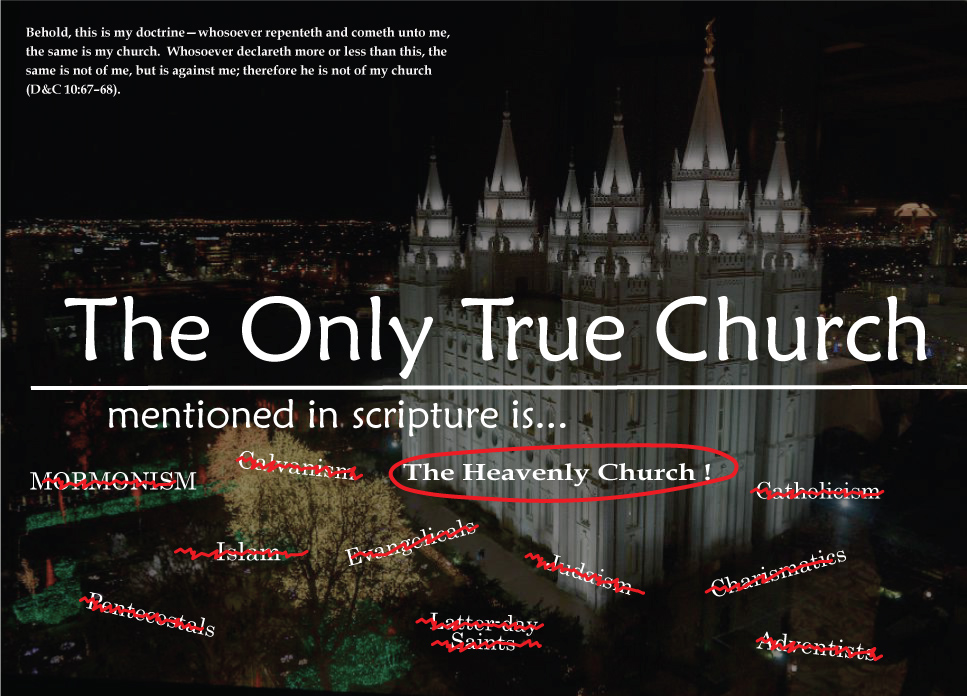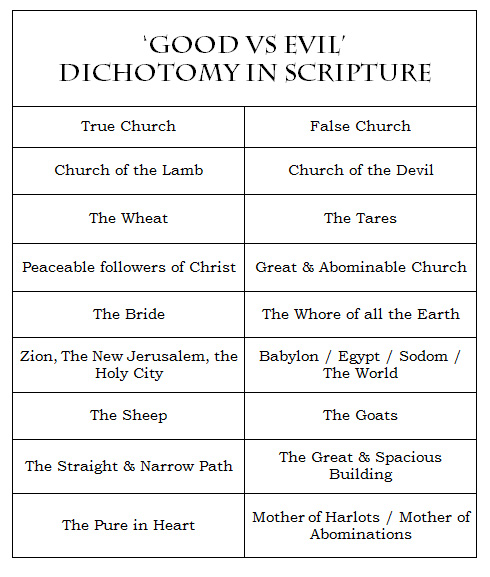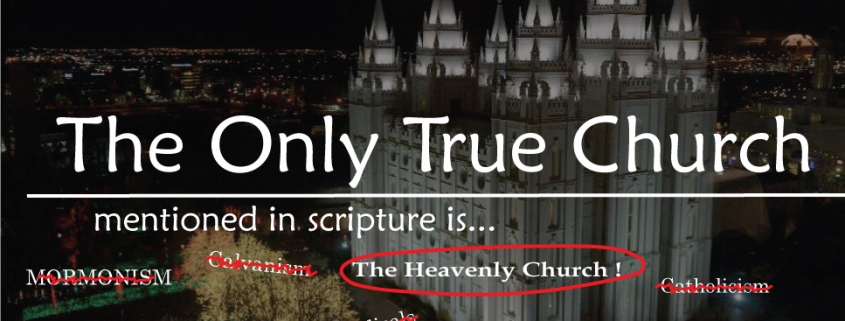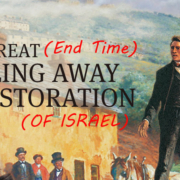Re-examining what the scriptures say about the “Only True Church” Doctrine

67 Behold, this is my doctrine—whosoever repenteth and cometh unto me, the same is my church.
68 Whosoever declareth more or less than this, the same is not of me, but is against me; therefore he is not of my church (D&C 10:67–68).
Introduction
In this article I hope to prove from the scriptures that the “only true and living church” mentioned in D&C 1 and alluded to in other parts of LDS scriptures is actually a heavenly or “spiritual church” which the temporal or earthly church is commanded to align with in order to be numbered with, and NOT an exclusivist Christian sect as seems to have been established in some circles of Mormon tradition.[def] I also hope to show in this and other articles in this series that Judaism, Christianity and Mormonism were created to be a symbols, archetypes and extensions of this heavenly church, which should seek to establish & bring forth a temporal version of the “true and living church” spoken of in D&C 1:30. The “only true church”, or Kingdom of god/heaven would be something earthly churches aspire to and lead people to, not an inherent right that comes with priesthood keys. The scriptures toward the end of this article hit the point home, and show that like Peter and other apostle’s constant misunderstanding of Jesus teachings—Joseph and modern church leaders may have also misunderstood and overlooked LDS scriptures which clearly teach that the “only true church” is a heavenly church instead of specific religious sect or denomination. A global spiritual brotherhood which all the good people and faiths of earth are destined toward if they follow the path of love and selflessness. It seems to this author that religious scripture, like good music and poetry, is made to be somewhat ambiguous on many issues, and cultures use that ambiguity to promote love and selflessness or egocentrism and pride. It is my hope that by looking at the following scriptural arguments that the LDS people might choose to focus on scriptures which promote religious pluralism, and not those which promote exclusivity and pride.
Zoramitism in the LDS Church
As much as I love the good in Mormonism, it seems to me that many of us in the LDS church have focused too much on a prideful reading of D&C 1:30, and discount an abundance of scriptural information to the contrary, in order to support the tradition of being “the only true church”. Like the biblical Pharisees and Zoramites in the Book of Mormon, we sometimes twist the scriptures in a manner that makes us think that God has “separated us” and “elected us to be saved”, while “all around us are elected to be cast by [his] wrath down to hell” (or lower kingdoms until we do their temple work). Understanding the pride inherent in our doctrines is the first step in unraveling what I believe to be egocentric scriptural interpretations which crept into the church from its earliest days. The similarities between the Book of Mormon account of the Zoramites and the average Mormon testimony in Fast & Testimony Meeting should be enough to convict us and open our hearts to the need to look closer at what the scriptures teach concerning the only true church doctrine. For those unfamiliar with the story of the Zoramites, let’s read through Alma’s experience for some insight into this extremely prideful sect—one that LDS people don’t want to be like!
12 Now, when they had come into the land, behold, to their astonishment they found that the Zoramites had built synagogues, and that they did gather themselves together on one day of the week, which day they did call the day of the Lord; and they did worship after a manner which Alma and his brethren had never beheld;
13 For they had a place built up in the center of their synagogue, a place for standing, which was high above the head; and the top thereof would only admit one person.
14 Therefore, whosoever desired to worship must go forth and stand upon the top thereof, and stretch forth his hands towards heaven, and cry with a loud voice, saying:
15 Holy, holy God; we believe that thou art God, and we believe that thou art holy, and that thou wast a spirit, and that thou art a spirit, and that thou wilt be a spirit forever.
16 Holy God, we believe that thou hast separated us from our brethren; and we do not believe in the tradition of our brethren, which was handed down to them by the childishness of their fathers; but we believe that thou hast elected us to be thy holy children; and also thou hast made it known unto us that there shall be no Christ.
17 But thou art the same yesterday, today, and forever; and thou hast elected us that we shall be saved, whilst all around us are elected to be cast by thy wrath down to hell; for the which holiness, O God, we thank thee; and we also thank thee that thou hast elected us, that we may not be led away after the foolish traditions of our brethren, which doth bind them down to a belief of Christ, which doth lead their hearts to wander far from thee, our God.
18 And again we thank thee, O God, that we are a chosen and a holy people. Amen.
19 Now it came to pass that after Alma and his brethren and his sons had heard these prayers, they were astonished beyond all measure.
20 For behold, every man did go forth and offer up these same prayers.
21 Now the place was called by them Rameumptom, which, being interpreted, is the holy stand. (Alma 31:12–21)
Although the beliefs of the Zoramites concerning the nature of God and Christ were different than our own, we come too close to sharing the same pride concerning salvation. Like all fundamentalist sects, the Zoramites saw themselves as a “chosen and holy people”. Like us, the Zoramites truly believed that their doctrines, divine election, (and likely priesthood & ordinances) made them the only true church, “elected by God to be saved”. They did not understand the following concepts taught by Nephi, and reiterated by Moroni, Jesus and other prophets—that until Zion is fully established & redeemed, the only true church is a spiritual church which transcends cultural and organizational lines.
The ‘Only Two Churches’ are ‘Spiritual Churches’ or Social Movements
I suggest the LDS concept of being the ‘only true church’ is promoted by a small handful of misunderstood scriptures. One example is Nephi’s vision of the two churches. In his vision given in 1 Nephi of the Book of Mormon, Nephi was taught that there are only two churches, the church of the Lamb of God (or the true church), and the church of the devil (the false church). This vision is often used to support the idea that there is only one true church on earth — however, since Nephi’s vision specifies that everyone on earth belongs to one of these two churches— it should be obvious that term “church” here is referring to a “spiritual” church or ideological allegiance and not just a temporal sect or ecclesiastical organization. Lets look at what the verse says,
10 And [The angel of the Lord] said unto me: Behold there are save two churches only; the one is the church of the Lamb of God, and the other is the church of the devil; wherefore, whoso belongeth not to the church of the Lamb of God belongeth to that great church, which is the mother of abominations; and she is the whore of all the earth. (1 Ne 14:10)
It should be apparent from the context of this verse, that the term “church” in this scripture, can not be referring to the most popular modern definition of the word church (which is a specific religious denomination). Since the verse says “there are save two churches only”, defining “church” as a denomination would mean there could only be two religious denominations in existence, and everyone on earth would have to be a member of one or the other.
As implied by the context and noted by other authors, the word church anciently, often had a much broader meaning than it does now (Hebrew qahal or edah; Greek ekklesia). For instance, in Greek texts it referred more broadly to a general assembly, or political association of people who bonded together and shared the same beliefs or loyalties. Scholars have noted that the modern concept of a church as a separate priesthood organization or religious denomination, didn’t exist among Jews of the first and second temple periods. Instead the differing religious groups or “schools of thought” as Josephus called them, were forced to work together to manage the Jewish theocratic state despite their conflicting ideologies.
In regards to Nephi’s vision of two churches, LDS apostles and church leaders have often misunderstood the scriptural use of the word “church” by arguing an inconsistent definition-— suggesting on one hand that the “church of the lamb of God” refers to a literal ecclesiastical organization (the LDS church and its ancient equivalent), but yet that the “church of the devil” refers to a figurative or spiritual church that transcends organizational lines. Others have tried to define the Church of the Devil in Nephi’s vision as the Catholic or American Evangelical Churches. However any interpretation to make either “the church of the Lamb of God” OR “the church of the devil” into literal Christian organizations or sects, contradicts the principle taught in Moroni 7 where he teaches that “every thing which inviteth to do good… is of God” and “whatsoever thing persuadeth men to do evil… is of the devil”.
16 For behold, the Spirit of Christ is given to every man, that he may know good from evil; wherefore, I show unto you the way to judge; for every thing which inviteth to do good, and to persuade to believe in Christ, is sent forth by the power and gift of Christ; wherefore ye may know with a perfect knowledge it is of God.
17 But whatsoever thing persuadeth men to do evil, and believe not in Christ, and deny him, and serve not God, then ye may know with a perfect knowledge it is of the devil; for after this manner doth the devil work, for he persuadeth no man to do good, no, not one; neither do his angels; neither do they who subject themselves unto him. (Moroni 7:16–17)12 And whatsoever thing persuadeth men to do good is of me; for good cometh of none save it be of me. I am the same that leadeth men to all good… (Ether 4:12)
The idea sometimes pushed by early church leaders that every other Christian denomination BUT the LDS church was the Church of the devil would be a complete contradiction to Moroni’s words. How could Catholicism or protestantism for instance be the “church of the devil” when the devil “persuadeth no man to do good[0], no not one; neither do his angels; neither do they who subject themselves unto him“! The idea is prideful and contradictory and has subsequently been abandoned by most modern LDS teachers. But at the same time, how could the LDS church be the “only true church” when according to Nephi and other scriptures THERE ARE ONLY TWO CHURCHES? According to Nephi’s vision, holding that the LDS denomination is the only true church requires all others to be part of the church of the devil, which as we will see in this article goes contrary to the words of Moroni, Christ’s and the Joseph’s Doctrine and Covenants. The answer to this apparent contradiction is that Both Moroni and Nephi for the most part taught a broad spiritual version of Christ’s true church. [1]
Is it any wonder that we are scorned as being a cult by other churches when we repeatedly infer that they are part of the church of the devil? (Perhaps some LDS members don’t realize it, but our insistence that we are the ONLY true church infers by definition that unlike us, all others are false!).

Early LDS Church leaders were not alone in their misunderstanding of the spiritual nature of the “church” Christ taught. In the New Testament John and other apostles make this same mistake when they forbid a man who would not follow them, from casting out demons by Christ’s name and authority. Jesus rebuked them and teaches the same principle as Nephi and Moroni. No-one who does good in Christ’s name is of the devil—and the apostolic followers weren’t the only one’s allowed to act with Christ’s authority. Because all who do good in Christ’s name are part of Christ’s spiritual church.
38 John said to Jesus, “Teacher, we saw someone forcing demons out of a person by using the power and authority of your name. We tried to stop him because he was not one of us.”
39 Jesus said, “Don’t stop him! No one who works a miracle in my name can turn around and speak evil of me.
40 Whoever isn’t against us is for us. (Mark 9:38–40 GWT)
Nephi makes essentially the same statement using reverse logic later in his writings as he explains the nature of both the true church of Christ and the False church of the devil. (Christ also says almost the exact thing in Matt 12:30)
“Wherefore, he that fighteth against Zion, both Jew and Gentile, both bond and free, both male and female, shall perish; for they are they who are the whore of all the earth; for they who are not for me are against me, saith our God.” (2 Nephi 10:16, see also Matt 12:30)
So Christ in one place says “whoever is not against us–is for us”, but in another place says (along with Nephi) “whoever is not for us–is against us” (see Matt 12:30). These statements are a complete contradictions if you try to define Christ’s church as a closed ecclesiastical organization. (see footnote 4) They can only be harmonized if you see them as a restatement of the same forced spiritual dichotomy used over and over in scripture which teaches that those who do good and are heading toward love are part of the spiritual church of God, and those who do evil and are fighting good are part of the church of the devil. And that every ecclesiastical church, sect, denomination, religion, person or nation is constantly aligning themselves with one or the other in everything they do–and will eventually have to chose allegiances in the heavenly or spiritual battle. Understanding this logic shows how the verses mentioned above support the idea of a spiritual church… and not just a temporal church.

The Good vs. Evil Dichotomy in Scripture
The binary or dichotomy of good vs. evil is taught throughout the scriptures. And perhaps nowhere is the idea that these terms transcend organizational lines taught better than in the parable of the wheat and the tares. In the parable the Master commands his servants to plant wheat in a field— but when it grows he find tares MIXED WITHIN the wheat. He tells his servants to allow them to grow together, least pulling out the tares, “ye root up also the wheat with them”. The meaning of this parable is explained not only in the New Testament but also in D&C 86 & 88, where we learn that that “the field was the world, and the apostles were the sowers of the seed” (D&C 86:2), the good seed are the children of Christ’s kingdom (true church), and the tares are the church of the devil or bad people and bad works that come from twisted doctrine (Matt 13:38, D&C 88:94).
37 …He that soweth the good seed is the Son of man;
38 The field is the world; the good seed are the children of the kingdom [Christ’s true church]; but the tares are the children of the wicked one [ie. devil’s church, see D&C 88:94];
39 The enemy that sowed them is the devil; the harvest is the end of the world; and the reapers are the angels.
40 As therefore the tares are gathered and burned in the fire; so shall it be in the end of this world.
41 The Son of man shall send forth his angels, and they shall gather out of his kingdom all things that offend, and them which do iniquity;
42 And shall cast them into a furnace of fire: there shall be wailing and gnashing of teeth.
43 Then shall the righteous shine forth as the sun in the kingdom of their Father. Who hath ears to hear, let him hear. (Matt 13:37–43, see also D&C 86:1–3)
Verse 38 (clarified in D&C 88:94) makes it clear that in this parable the wheat are the kingdom or church of Christ, and the tares are the ‘kingdom or church of the devil’. And the whole point of the parable is that it is hard to tell the difference between the two because they look so similar and grow together within each organization! Both the wheat and the tares exist within every religion, culture and kingdom. There are tares in “Christ’s Kingdom”, and wheat among the Gentiles. But it is not until “the end of the world” (end or close of the age in most translations) that Christ and his angels (not mortal servants) will separate the two; gathering the wheat into heaven and burning the tares with the stubble to prepare a new crop cycle. [2].
[[defs]]Spiritual Church: A social movement. A state of being. A type of spiritual nature or character which binds like-minded people together. And organization which exists in heaven with which people can align themselves in thought and behavior.Organizational or Temporal Church: A specific religious organization or denomination on the earth, bound together by specific ordinances, priesthood and leadership.[[defs]]








But what about the priesthood?!
Not sure how I never really noticed or thought about D&C 10:67 before…
Crazy how much these scriptures sound like the typical protestant argument. Or essentially what the prodestants have been telling the Catholics for hundreds of years….
This is a nice article and addresses an important area.
But tscc can’t change this just like they can’t change the same sex issue. It is too far into their fundamental views. You have to do this, and this, and this, and this to make it into vip heaven. It would cancel too much of mormonism for them to be recognizable (still better than everyone else) on the other side.
The rifts were necessary for the time before this era in order to avoid the effects of possible diffusion. Diffusion is tripping up all too many as they allow others to shame them out of the church or over study expecting intellectual or natural man methods to suffice and thereby our smart themselves?
How do we know that the time was not right before this? And what the Lord wants? Easy, by what was and what is-is He God or what? Still at head and in the lead of the church, LDS and the complete Christian movement and IMO all the world religions. With emphasis on the promise to the children of Abraham.
How do you know where he wants you? Where you are right now for this part of journey with Him? I think our foibles and missteps have all been factored in but that is just my opinion.
P S, we don’t even have to compete and compare with others of different thoughts since to do so is prideful and minding our own business can be a virtue (as we spread the In our opinion good news of the gospel in the fullest form–so far. That used to be preached much more in my youth–the changing church as we get the need and capacity for more? Truest church but not yet perfect?
D&C 10:67: What does “cometh unto me” mean? So many different interpretations, including the need to receive the “ordinances of salvation” by the “proper authority.”
Do you know of any LDS scripture that directly says or infers that “coming unto Christ”, REQUIRES physical/temporal ordinances? As I’ve investigated the scriptures that I used as a missionary to insinuate a requirement for priesthood or ordinances… I’ve come to believe we misuse and misinterpret them as a church. (ie Heb 5:4, D&C 84:19–21, D&C 76). It is not the temporal ordinance or the temporal church with power to save a soul… it is the spiritual ordinance (which occurs in one’s heart) and the spiritual church (which dwells in heaven) that eternally saves. Membership and baptism are meaningless without the mighty change of heart or spiritual rebirth which should accompany it. The temporal is simply a symbol pointing us to the spiritual, IMO.